Aztec Games
The Aztecs did do work, and fought, and build pyramids, but they also played... a lot. Games were a huge part of life, religion, and even politics. From deadly serious ballgames to board games where you could bet your house, here's a look at how the Aztecs had fun.
The Central Role of Aztec Games
A Cornerstone of Life
For the Aztecs (or the Mexica, if you want to be specific), games were a big deal. They were tied into everything, culture, religion, politics, you name it. Many games were linked to religious rituals and beliefs.
They even had a god just for games, music, and feasting, Macuilxochitl (Five Flower), also known as Xochipilli (Flower Prince). The Aztecs seemed to believe that free time needed a purpose. So even their fun was organized and full of meaning, helping to teach cultural values or sharpen useful skills.
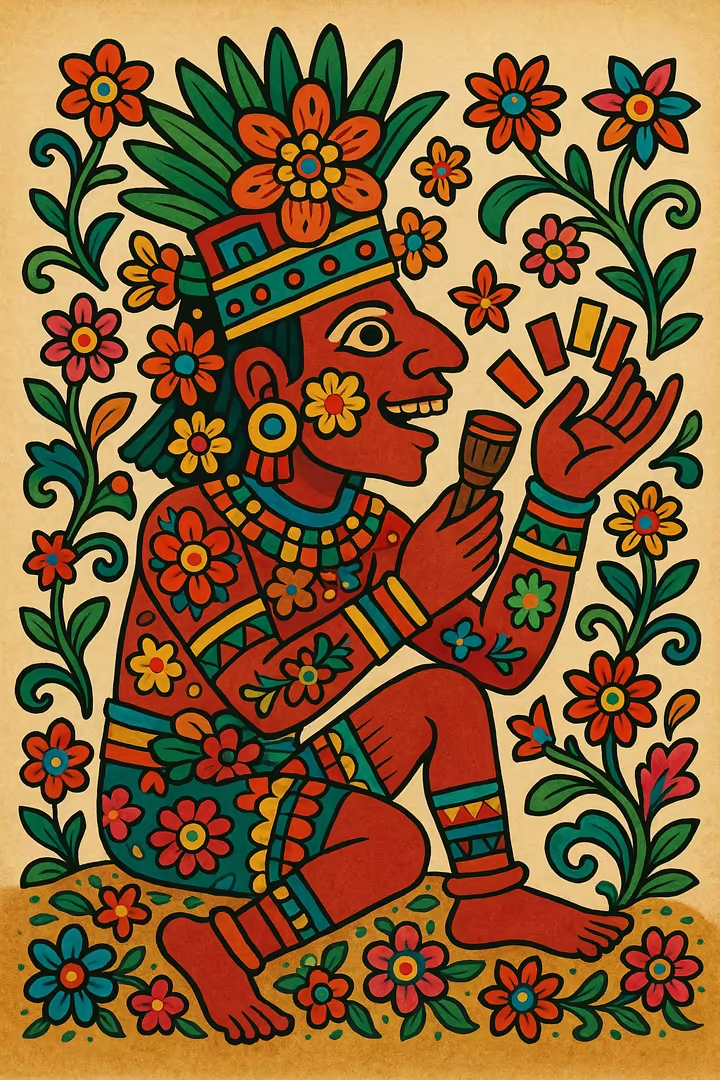
Ōllamaliztli: The Sacred Aztec Ball Game
The famous Mesoamerican ballgame was called Ōllamaliztli by the Aztecs. Its history stretched back thousands of years before them. For the Aztecs, this game was a complex tradition packed with religious, political, and social meaning.
How it Was Played
The main goal was to keep a solid rubber ball, called an ulli, in constant motion. Players, usually on two teams, could only hit the ball with their hips, knees, or elbows. Using hands or feet was a big no, no, which made the game incredibly difficult.
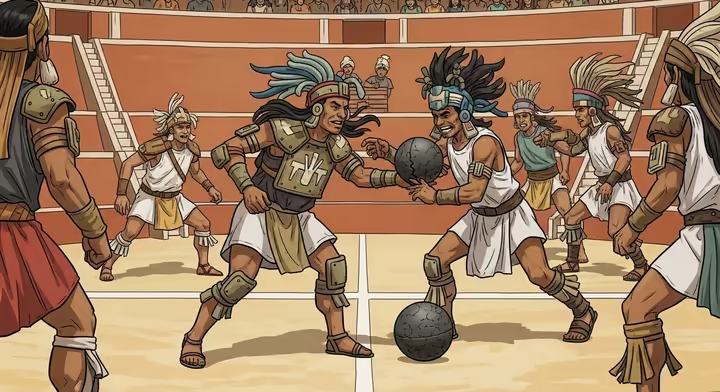
Scoring was tricky. An early version of the game might have focused on getting the ball to the other team's end of the court. Later, stone markers were added to the walls for points.
The most exciting way to score was getting the ball through a stone hoop, called a tecainmal, set high on the side walls. This was so hard to do that a single hoop shot usually meant an instant win. But not all courts had these hoops, especially older ones.
While the "hip-ball" version was most common, other styles of the game might have existed. Some stories suggest players used forearms or even bats and rackets in different regions.
The Tlachtli Ballcourt
The special court for Ōllamaliztli was called a tlachtli. It was usually shaped like a capital 'I', with a long, narrow playing area and sloped walls on either side. In the Aztec capital, Tenochtitlan, the main court was called the teotlachco, or "holy ball court."
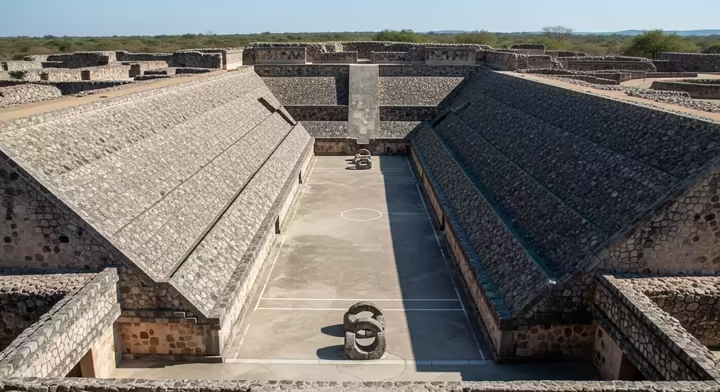
These courts were important. They were often built in the center of cities, right next to major temples. In Tenochtitlan, the court was near the Templo Mayor, the city's main temple.
Right next to the court, you'd often find a tzompantli, a giant rack for displaying the skulls of sacrificed people. This grim setup shows that Ōllamaliztli was a core part of the state's religious and political life.
Gearing Up for the Game
The star of the show was the ulli, a solid rubber ball. These balls could be heavy, weighing up to 9 pounds! A ball that heavy made the game dangerous, and players often ended up "bruised and bleeding."
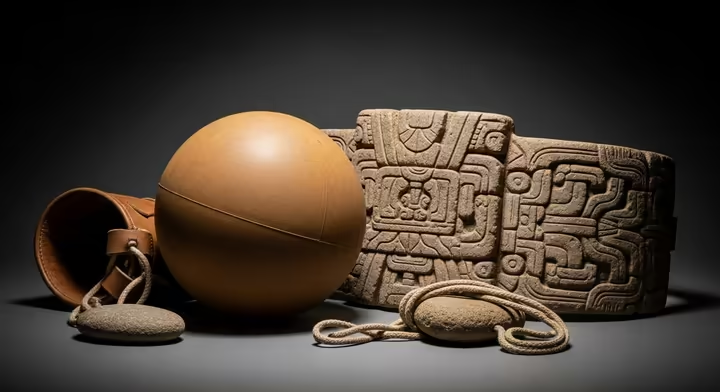
To protect themselves, players wore thick leather padding on their hips and thighs, along with loincloths. Gloves and knee pads were also common. They also wore a U-shaped "yoke" around their waist, probably made of wood or wicker for actual games.
Archaeologists have found many heavy stone yokes. These were likely ceremonial versions used in rituals or buried with players as gifts.
A Game of Gods
Ōllamaliztli was a symbolic performance of the cosmic order. It represented the battle between forces like life and death, or day and night. The court itself was seen as a link between the heavens and the underworld.
The moving ball symbolized the sun's daily journey across the sky and through the underworld at night. This journey was seen as a cosmic fight between the sun god, Huitzilopochtli, and the forces of darkness (the moon and stars). Playing the game was a way to honor the gods and keep the universe in balance.
Human sacrifice was a grim part of the game. Victims, often from the losing team (but maybe even the winners, as a high honor), were frequently decapitated. This was done to repay the gods and ensure that life continued.
A Game of Power
In Aztec society, Ōllamaliztli was mostly for the elite, the nobles and rulers. Their children were trained to play from a young age. The game was a way to show off warrior strength and athletic skill, much like the fierce imagery seen in Aztec Warrior Art.
Gambling was a huge part of the ballgame scene. Nobles would bet massive amounts of jewels, goods, slaves, and even land on the outcome. Professional players who weren't nobles also gambled heavily, since their livelihood depended on winning.
The game also had serious political uses. It could be used to settle arguments between cities, acting as a substitute for war. Or, a game could be used as a cover for political plots, like an assassination.
Patolli: The Aztec Board Game of Fate
Patolli was another super popular Aztec game. It was a game of racing and luck, a bit like Parcheesi or Ludo. But for the Aztecs, Patolli was deeply connected to their economy, social life, and beliefs about the universe.
How to Play Patolli
We don't know the exact original rules, but we have a pretty good idea. Patolli was a race game played on a cross-shaped board, often drawn on a reed mat called a petate. The board had spaces, often 52 in total, matching the 52 years in an Aztec "century."
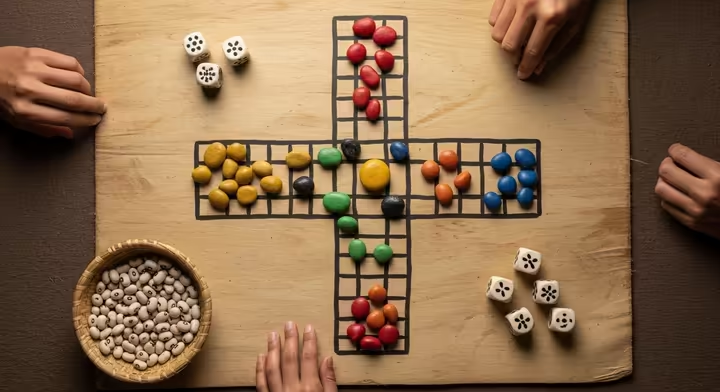
Players used colored pebbles as their game pieces. To move, they threw five large black beans that worked like dice. Each bean had a white mark on one side, and the number of marks facing up was your score for the turn.
The goal was to get all your pieces around the board and off again. You couldn't land on a space already taken by another piece. The first player to get all their pieces off won the pot that everyone had bet into.
Patolli in Stone and Print
Archaeologists have found Patolli boards carved into rocks, plaster floors, and even on pottery in graves. This shows the game was played all over and by many different people. Old picture-books, or codices, also give us great clues.
Books like the Florentine Codex, Codex Mendoza, and Codex Magliabechiano all show people playing Patolli. They often picture the game's god, Macuilxochitl, watching over the players. This proves how important and widespread the game was.
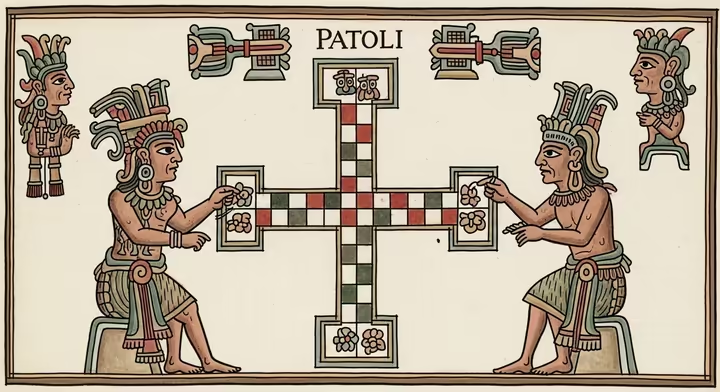
Society and Fortunes
Everyone loved Patolli, from commoners to nobles. Even the emperor Moctezuma II supposedly enjoyed watching his nobles play. Both men and women played the game.
Gambling was the heart of Patolli. Players bet everything, blankets, food, gold, and sometimes even their homes, families, or their own freedom. This intense gambling could lead to ruin, and some people became addicted, losing everything they owned.
There were even professional Patolli gamblers who traveled around with their game mats, looking for a match. Winning big could make you rich, but losing could mean becoming a slave. The game was a wild ride of high risk and high reward.
Gods and Prophecy
Patolli was packed with religious meaning. Its main god was Macuilxochitl (Five Flower), who was in charge of games, fate, and pleasure. Gamblers would pray to him for good luck before a game.
The game was also a calendar. The 52 spaces on the board matched the 52-year cycle of the Aztec calendar. Playing the game was like interacting with cosmic time and destiny.
Because of this, Patolli was also used to tell the future. A big bet was a way of testing your fate. Playing the game was like having a direct conversation with the forces that ruled the universe.
Sky Dancers and Pole Climbers
Some of the most spectacular Aztec rituals involved performances high up on tall poles. These included the famous Volador ceremony and a competitive pole-climbing event.
The Volador Ceremony
The Danza de los Voladores, or "Dance of the Flyers," is an ancient ceremony still performed today. Five men take part. Four of them, the "flyers," dress in bird costumes, while the fifth, a musician, stays at the top of a very tall pole.
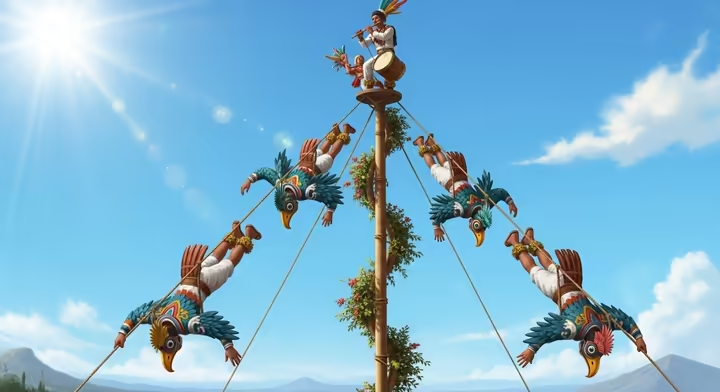
The ritual begins with all five men climbing a pole that can be over 100 feet high. At the top, the musician plays a flute and drum while dancing on a tiny platform. Then, the four flyers leap headfirst from the platform.
Tied by ropes, they descend in wide, sweeping circles, like birds in flight. They spin around the pole until they land gently on the ground.
Flying with Meaning
The Volador ceremony is full of meaning. It's a fertility ritual meant to please the gods and bring rain for good harvests. The pole itself is seen as a link between the sky, the earth, and the underworld.
It's also another calendar. Each of the four flyers usually makes thirteen turns around the pole. Four flyers times thirteen turns equals 52... the exact number of years in the Aztec calendar cycle.
The Xocotl Huetzi Pole Climb
A different ritual was the pole-climbing contest during the festival of Xocotl Huetzi ("Falling Fruit"). This event honored Xiuhtecuhtli, the fire god. It was a yearly competition for young Aztec men.
A massive tree was set up in the main courtyard of the Templo Mayor. At the top, they placed a bird figure made of amaranth dough, along with other prizes like banners and food. Young noblemen would then race to be the first to climb the pole and grab the goodies.
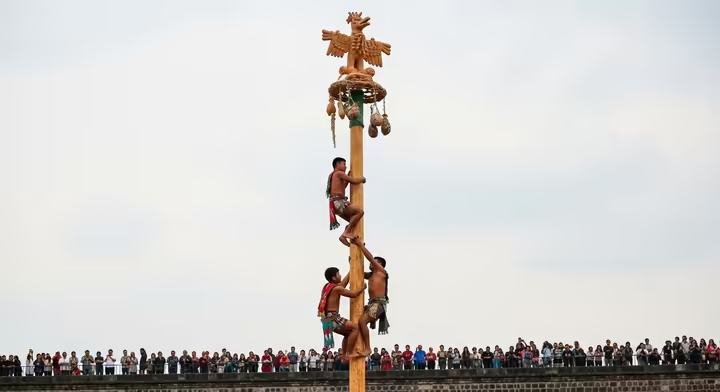
While both rituals used a pole, they were different. The Xocotl Huetzi event was a competition for prizes and status. The Volador was a ceremony about cosmic renewal and the calendar.
Did the Mexica Practice the Volador?
Yes! Even though the ceremony is often linked to other groups, there's strong proof the Aztecs performed the Volador dance. Spanish writers who saw it described dancers who seemed to "fly." Most importantly, the friar Sahagún wrote about it, clearly linking the 52 turns of the flyers to the 52-year Aztec calendar cycle.
A Spectrum of Aztec Games and Leisure
Besides the big-name games, Aztecs had lots of other pastimes. There were games of skill, warrior training, and plenty of fun for kids.
Totoloque: Aiming for Gold
Totoloque was a popular gambling game of skill. The idea was to throw small pellets, supposedly made of gold, to hit a target.
The Spanish writer Bernal Díaz del Castillo wrote that the emperor Moctezuma II played this game with Hernán Cortés. This suggests the game was a way for two powerful leaders from different worlds to socialize during a very tense time. It was a sort of casual diplomacy over a simple game of aim.
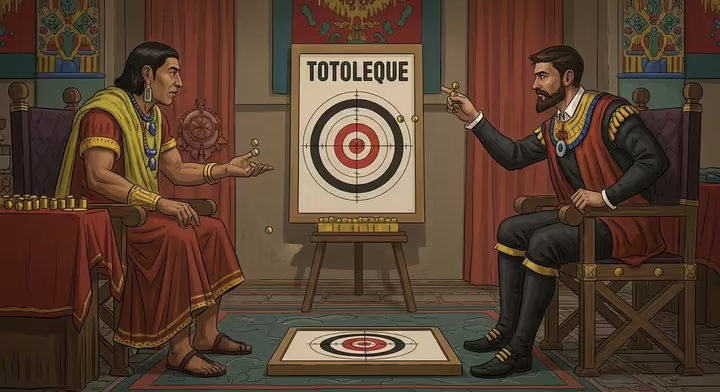
Growing Up with Aztec Games
Kids' games were a big part of learning how to be an Aztec. Toys were often tiny versions of adult tools and taught kids their expected roles from a young age. Boys got mini weapons and farming tools, while girls got mini weaving looms and household items.
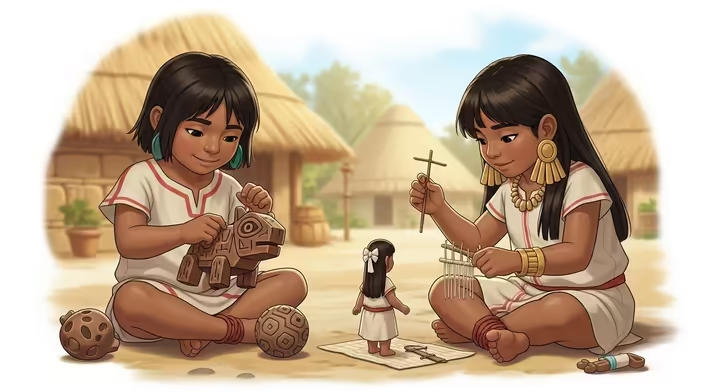
Aztec kids played lots of games too. There was *Cocoyocpatolli* ("hole game"), where you'd toss stones into a hole. They played something like marbles called *Chichinadas*, and a hand-catch guessing game called *Mapepenas*.
Music, Dance, and Stories
Music, dance, and storytelling were essential parts of Aztec fun and ritual. Music was everywhere, from home worship to big temple ceremonies. Instruments included drums like the upright huehuetl and the log drum teponaztli, plus rattles and flutes.
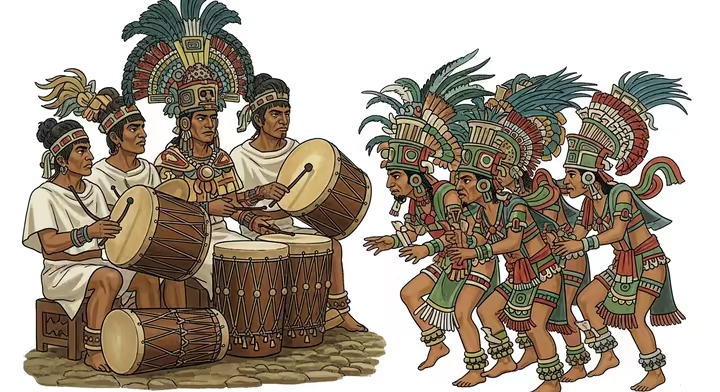
Dance was a highly developed art, sometimes called "singing with their feet." Dancers often wore elaborate costumes for their coordinated ceremonial moves. Storytelling was also crucial for passing down myths, legends, and history from one generation to the next.
The Warrior's Path: Training Games
Since Aztec society was all about warfare, many training activities took the form of warrior games. Boys went to special schools to learn fighting skills, weapon use, and tactics. This included mastering the obsidian-bladed sword called a macuahuitl and the spear-thrower known as an atlatl.
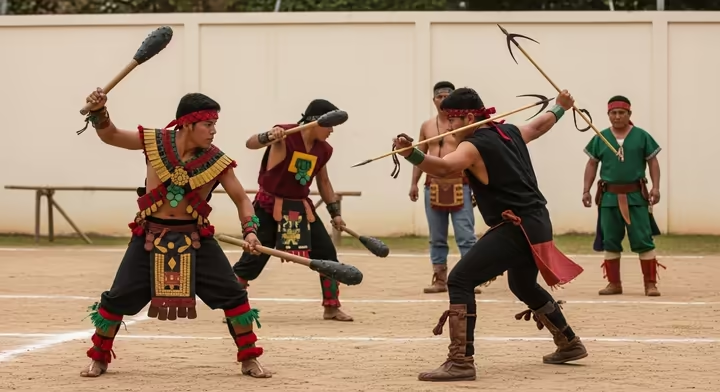
Ritual battles and practice fights were also part of ceremonies and entertainment. They even had mock battles using net bags filled with soft things like flowers. These events were playful but still helped teach warrior values.
Life on the Water
The Aztec capital, Tenochtitlan, was a city built on an island in a lake. This meant water skills were super important. Canoes, or acalli, were the main way to get around, used for moving goods, troops, and everything in between.

The Spanish said the Aztecs were amazing swimmers, both men and women. Kids learned to swim as soon as they could walk. With water everywhere, it's likely they had casual fun like canoe races or swimming contests, even if they weren't big official events.
Markets and Court Shows
The huge marketplaces, like the one at Tlatelolco, were lively social hubs where people met to chat, gossip, and hang out.
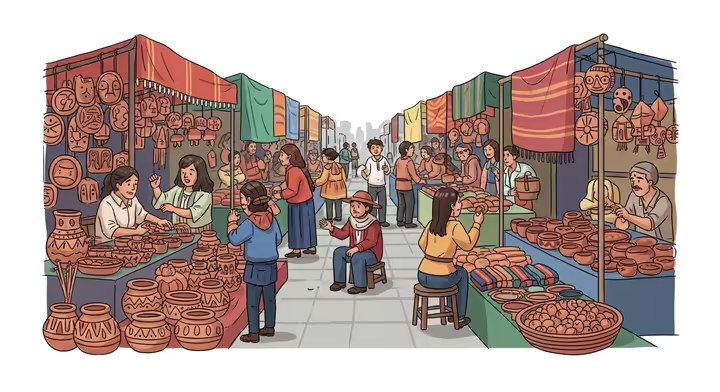
The emperor's court had more formal entertainment. Rulers and nobles watched shows by jesters, acrobats, and dwarfs. One amazing act was log juggling, where acrobats would lie on their backs and expertly toss a heavy log with their feet.
Interpreting the History of Aztec Games
What we know about Aztec games comes from a mix of old historical accounts, native picture-books (codices), and stuff dug up by archaeologists. Each source gives us clues, but also has its own challenges.
Old Writings and Picture-Books
After the Spanish arrived, they wrote a lot about Aztec life. Friars like Bernardino de Sahagún (in his Florentine Codex) and Diego Durán wrote detailed accounts of games like Ōllamaliztli and Patolli. Their goal was often to understand native culture in order to convert people to Christianity, so their views can be biased.
They often compared Aztec games to European ones, calling Patolli "like dice," which could oversimplify the real meaning of these activities. Indigenous codices, like the Codex Mendoza and Codex Magliabechiano, are also vital. These picture-books, often drawn by native artists, give us visual evidence of how games were played and who played them.
Digging for Clues
Archaeology gives us physical proof. Over 1,500 ballcourts have been found across Mesoamerica, showing how widespread the game was. Carved Patolli boards have been found on rocks and floors, and archaeologists have even discovered ancient rubber balls.
This physical evidence often backs up what the old texts say. But it also shows that these games were much older and more varied than the Aztec-focused stories let on. Mexico's National Institute of Anthropology and History (INAH) is still finding new sites and learning more all the time.
The Evolution of Aztec Games
The Aztecs didn't invent these games, they inherited them. The Olmec civilization, way back around 1400 BCE, is credited with starting the ballgame. The great city of Teotihuacan also played both the ballgame and Patolli hundreds of years before the Aztecs came along.
The Aztecs took these ancient traditions and made them their own. They wove the games into their own empire's beliefs, linking Ōllamaliztli to their main god Huitzilopochtli. They put their own unique spin on pastimes that were centuries old.
A Shared Playground
The Aztecs weren't the only ones playing these games. The Maya played a very similar ballgame called Pitz. The Mixtec and Zapotec of Oaxaca also played the ballgame and Patolli.
This shared heritage of games across Mesoamerica shows deep, ancient connections between these cultures. While the rules might have been a little different here and there, the basic ideas were the same.
Survival of Aztec Games After Conquest
When the Spanish arrived, they put a stop to many native games. They saw them as "pagan" and linked to idolatry and gambling. Games like Ōllamaliztli and Patolli were especially targeted, and game boards and gear were often destroyed.
But some traditions survived. The ancient ballgame changed into modern forms like Ulama, which is still played today in parts of Mexico. Patolli also survived in some communities, and the Volador ceremony is still performed, though it now includes some Catholic elements.
The Spanish also brought their own games, like handball, which was adapted by the people of Oaxaca into a new game called pelota mixteca. This mix of suppression, survival, and change shows how strong native culture was.
Myths and Modern Echoes of Aztec Games
Aztec games and culture still pop up today, though not always accurately. It's worth clearing up a few common myths.
Setting the Record Straight
There is no historical evidence for an "Aztec Tetris." This is a modern term for fabric patterns with geometric shapes. Likewise, the "Aztec Highland Games" is actually a modern Celtic festival in Aztec, New Mexico, its name is a coincidence and has nothing to do with real Aztec games.
Aztecs in Pixels: Modern Video Games
Aztec culture has inspired many video games, like Age of Empires and Civilization. These games often try to be visually accurate, showing Tenochtitlan's buildings or warrior outfits. But they also simplify complex cultural ideas to make the game fun.
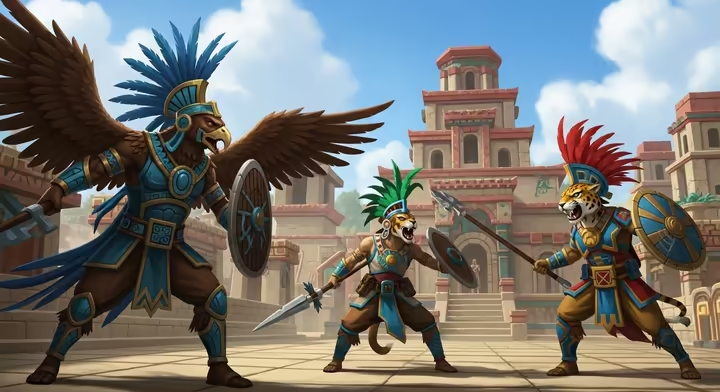
Older games especially have been criticized for using harmful stereotypes. Even newer games can misrepresent cultures if they're not careful. Game mechanics often prioritize fun over strict historical truth.
So while video games can be a fun entry point, it's good to look at them with a critical eye. They are entertainment, not a history lesson.
The Enduring Legacy of Aztec Games
Aztec games were essential parts of their society, religion, and politics. From the deadly rituals of Ōllamaliztli to the cosmic board game Patolli, these activities were woven into the heart of Aztec life.
They were powerful tools for teaching values, showing status, and even settling political disputes. Even after the Spanish tried to stamp them out, the survival of games like Ulama shows the lasting power of these ancient traditions.
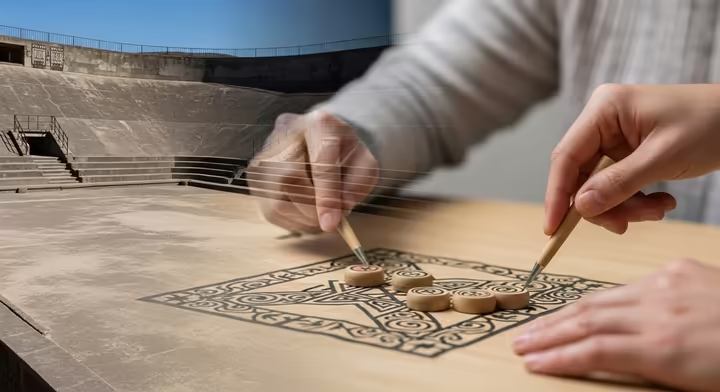
Looking at how the Aztecs played gives us a unique window into their complex world. It shows us that for the Aztecs, as for all humanity, games were a vital part of being human.